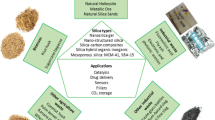Abstract
Silica (SiO2) is one of the most important inputs for the food, pharmaceutics, polymer composite, and ink manufacturing industries. In ceramic materials, fine silica particles are widely used as a packing and sintering aid and to produce other raw materials like mullite (3Al2O3·2SiO2) and silicon carbide (SiC). As most of the silica sources found in nature have relatively low purity and nonhomogeneous properties, use of synthetic grades of silica is necessary in applications such as refractories and technical ceramics that require better control of product composition and microstructure. This paper describes a systematic comparison of four grades of synthetic amorphous silica (SAS) used in technical ceramics. The evaluated SAS materials were formulated by different methods (sodium silicate precipitation, SiCl4 pyrolysis, extraction from rice husks, and physical deposition of silicon vapour). Differences in the physicochemical and thermal and microstructural characterization of each material are related to the principles and techniques involved in their manufacture. The study verified that synthesis conditions strongly influenced the composition and physical properties of the tested SAS samples.
Similar content being viewed by others
References
Hahn, B.R., Johnson, E.L., Melaiye, A.M., Jiang, B., Kinsey, R.A.: (The Goodyear Tire & Rubber Company-US) US 8,440,750 B2, 14 May 2013
Schaal, S., Coran, A.Y., Mowdood, S.K.: (Pirelli Pneumatici S.P.A.-IT) WO 01/64782 A1, 07 September 2001
Menezes, R.R., Fagury-Neto E., Fernandes, M.C., Souto, P.M., Kiminami, R.H.G.A.: Porous mullite obtained using silica from rice husk and aluminum acetate (in Portuguese). Cerâmica 54 (2008) 245–252
Schneider, H., Schreuer, J., Hildmann, B.: Structure and properties of mullite: A review. J. Eur. Ceram. Soc. 28 (2008) 329–344
Liu, N., Huo, K., McDowell, M.T., Zhao, J., Cui, Y.: Rice husks as a sustainable source of nanostructured silicon for high performance Li-ion battery anodes. Scientific Reports 3 (2013) [1919] 1–7
Reinhardt, H., Abitzsch, G. (Henkel Kommanditgeesellschaft Auf Aktien.-DE), 0 306 828 A3, 01 September 1988
Novotny, R., Hoff, A., Schuertz, J. (Henkel Kommanditgeesellschaft Auf Aktien.-DE), WO 90/08733, 09 August 1990
Ma, X., Zhou, B., Gao, W., Qu, Y., Wang, L., Wang, Z., Zhu, Y.: A recyclable method for production of pure silica from rice hull ash. Powder Techn. 217 (2012) 497–501
Moerters, M., Jacobsen, H., Schumacher, K. (Degussa AG, Duesseldorf-DE), US Patent 7 541 014 B2, 02 June 2009
Iler, R.K.: The colloid chemistry of silica and silicate. Edit. Ithaca, New York (1979) 1–250
Real, C., Alcalá, M. D., Criado, J.M.: Preparation of silica from Rice Husks. J. Am. Ceram. Soc. 79 (1996) [8] 2012–2016
Dastol, M., Tveit, H., Dingsoyr, E.O., Ronning, P., Harsaker, S. (Elkem A/S-NO), PI patent 9407106-3A, 19 July 1994
Rahaman, M.N.: Ceramic Processing and Sintering, 2th Ed. Marcel Dekker, New York (2003) 150
Plank, J., Schroefl, C., Gruber, M., Lesti, M., Sieber, R.: Effectiveness of polycarboxylate superplasticizers in ultra-high strength concrete: the importance of PCE compatibility with silica fume. J. Adv. Concrete Techn. 7 (2009) [1] 5–12
Lowell, S., Shields, J.E.,: Powder Surface Area and Porosity, 3rd Ed. Chapman & Hall, London (1991) 56
International Union of Pure and Applied Chemistry IUPAC. Reporting data for gas/solid systems with special reference to the determination of surface area and porosity. Pure Appl. Chem. 57 (1985) [4] 603–19
Quercia, G., Lazaro, A., Geus, J.W., Brouwers, H.J.H.: Characterization of morphology and texture of several amorphous nano-silica particles used in concrete. Cement and Concrete Comp. (2014) (in press)
Sun, L., Gong, K.: Silicon-based materials from rice husks and their applications. Ind. Eng. Chem. Res. 40 (2001) 5861–5877
Chandrasekhar, S., Pramada, P.N., Raghaven, P., Satyanarayana, K.G., Gupta, T.N.: Microsilica from rice husk as a possible substitute for condensed silica fume for high performance concrete. J. Mater. Sci. Let. 21 (2002) 1245–1247
Lim, H.M., Lee, J., Jeong, J.H., Oh, S.G., Lee, S.H.: Comparative study of various preparation methods of colloidal silica. Engineering 2 (2010) 998–1005
Salomão, R., Souza, A.D.V., Fernandes, L., Arruda, C.C.: Advances in nanotechnology for refractories: When very small meets hot, heavy, and large. Am. Ceram. Soc. Bull. 92 (2013) [7] 22–28
Author information
Authors and Affiliations
Corresponding author
Rights and permissions
About this article
Cite this article
Fernandes, L., de Arruda, C.C., Souza, A.D.V. et al. Characterization of Synthetic Amorphous Silica (SAS) Used in the Ceramics Industry. Interceram. - Int. Ceram. Rev. 63, 220–224 (2014). https://doi.org/10.1007/BF03401063
Received:
Published:
Issue Date:
DOI: https://doi.org/10.1007/BF03401063



